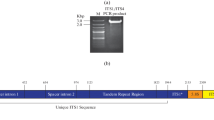Summary
We have examined five nuclear group I introns, located at three different positions in the large subunit ribosomal RNA (LSU rRNA) gene of the two myxomycete species, Didymium iridis and Physarum polycephalum. Structural models of intron RNAs, including secondary and tertiary interactions, are proposed. This analysis revealed that the Physarum intron 2 contains an unusual core region that lacks the P8 segment, as well as several of the base-triples known to be conserved among group I introns. Structural and evolutionary comparisons suggest that the corresponding introns 1 and 2 were present in a common ancestor of Didymium and Physarum, and that the five introns in LSU rRNA genes of these myxomycetes were acquired in three different events. Evolutionary relationships, inferred from the sequence analysis of several different nuclear group I introns and the ribosomal RNA genes of the intron-harbouring organisms, strongly support horizontal transfer of introns in the course of evolution. We propose a model that may explain how myxomycetes in natural environments obtained their nuclear group I introns.
Similar content being viewed by others
References
Belfort M (1991) Cell 64:9–11
Burke JM (1988) Gene 73:273–294
Burke JM, Esherick JS, Burfeind WR, King JL (1990) Nature 344:80–82
Cech TR (1988) Gene 73:259–271
Cech TR (1990) Annu Rev Biochem 59:543–568
Collins RA (1988) Nucleic Acids Res 16:2705–2715
Couture S, Ellington AD, Gerber AS, Cherry JM, Doudna JA, Green R, Hanna M, Pace U, Rajagopal J, Szostak JW (1990) J Mol Biol 215:345–358
Dávila-Aponte JA, Huss VAR, Sogin ML, Cech TR (1991) Nucleic Acids Res 19:4429–4436
Douglas SE, Murphy CA, Spencer DF, Gray MW (1991) Nature 350:148–151
Dujon B (1989) Gene 82:91–114
Edman JC, Kovacs JA, Masur H, Snati DV, Elwood HJ, Sogin ML (1988) Nature 334:519–522
Engberg J, Nielsen H, Lenaers G, Murayama O, Fujitani H, Higashinakagawa T (1990) J Mol Evol 30:514–521
Fitch WM, Margoliash E (1967) Science 155:279–284
Guo Q, Akins RA, Garriga G, Lambowitz AM (1991) J Biol Chem 266:1809–1819
Heinemann JA, Sprague GFJ (1989) Nature 340:205–209
Hicke BJ, Christian EL, Yarus M (1989) EMBO J 8:3843–3851
Huss VAR, Sogin ML (1990) J Mol Evol 31:432–442
Johansen S (1991) DNA Sequence-J DNA Seq Map 2:193–196
Johansen S, Johansen T, Haugli F (1992) Curr Genet 22:305–312
Lambowitz AM (1989) Cell 56:323–326
Lambowitz AM, Perlman PS (1990) Trends Biochem 15:440–444
Lenaers G, Maroteaux L, Michot B, Herzog M (1989) J Mol Evol 29:40–51
Michel F, Dujon B (1983) EMBO J 2:33–38
Michel F, Westhof E (1990) J Mol Biol 216:585–610
Michel F, Ellington AD, Couture S, Szostak JW (1990) Nature 347:578–580
Mohr G, Lambowitz AM (1991) Nature 354:164–167
Muscarella DE, Vogt VM (1989) Cell 56:443–454
Muscarella DE, Ellison EL, Ruoff BM, Vogt VM (1990) Mol Cell Biol 10:3386–3396
Nielsen H, Engberg J (1985) Nucleic Acids Res 13:7445–7455
Nishikawa M, Suzuki K, Yoshida K (1992) Curr Genet 21:101–108
Noller HE, Kop J, Wheaton V, Brosius J, Gutell RR, Kopylov AM, Dohme F, Herr W, Stahl DA, Gupta R, Woese CR (1981) Nucleic Acids Res 9:6167–6189
Nomiyama H, Kuhara S, Sukita T, Otsuka T, Sakaki Y (1983a) Nucleic Acids Res 9:5507–5520
Nomiyama H, Sakaki Y, Takagi Y (1981b) Proc Natl Acad Sci USA 78:1376–1380
Ragnini A, Grisanti P, Rinaldi T, Frontali L, Palleschi C (1991) Curr Genet 19:169–174
Skelly PJ, Maleszka R (1991) Curr Genet 19:89–94
Sogin ML, Edman JC (1989) Nucleic Acids Res 17:5349–5359
Vogt VM, Braun R (1976) J Mol Biol 106:567–587
Wilson C, Fukuhara H (1991) Curr Genet 19:163–167
Woodson SA, Cech TR (1989) Cell 57:335–345
Author information
Authors and Affiliations
Rights and permissions
About this article
Cite this article
Johansen, S., Johansen, T. & Haugli, F. Structure and evolution of myxomycete nuclear group I introns: a model for horizontal transfer by intron homing. Curr Genet 22, 297–304 (1992). https://doi.org/10.1007/BF00317925
Received:
Issue Date:
DOI: https://doi.org/10.1007/BF00317925




